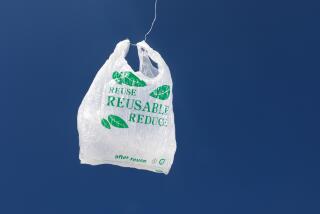The latest in green fashion: caps and gowns
Caltech’s graduating class marched across the stage at Friday’s commencement ceremony bedecked in more than 12,000 plastic bottles.
And it wasn’t a prank.
More than 500 graduates of a school known for elaborate ruses — such as changing the Hollywood sign to read “Caltech” — donned garments made entirely of fabric spun from molten plastic pellets instead of the traditional polyester caps and gowns.
Graduation planners around the country are greening their ceremonies, cutting back on printed materials and balloons filled with non-renewable helium and choosing compostable dinnerware, biodegradable water bottles and campus-grown floral displays.
But to graduates such as Catherine Beni, who at 20 years old is the youngest ever to receive a doctorate from Caltech, the eco-friendly regalia was more an “interesting factoid” than something to brag about.
“It feels exactly the same as the polyester gowns,” the Riverside native said. “Maybe on a hotter day, I would notice the difference. And because it’s my PhD, I would have preferred a nicer gown that I would want to keep, but maybe for others, this’ll be extremely useful because it would all otherwise go to waste.”
The environmental movement is growing at schools, which are adding sustainability courses to their schedules and commissioning eco-friendly lecture halls, but skeptics say greening graduation garb might be more a marketing gimmick.
Jostens Inc., a maker of academic products, recently introduced a gown made from wood-based fiber that decomposes in soil. Critics said graduates were likely to rewrap them in the plastic cover before throwing them out, preventing the fiber from biodegrading. The company’s outfits now come in packaging that it says breaks down in landfills.
At Caltech, school officials set up special recycling bins around campus for the gowns. The outfits, which were produced by Salem, Va.-based Oak Hall Cap and Gown, are to be reworked into new fabric, perhaps for next year’s graduation.
Oak Hall, which has been making cap and gowns for more than a century, introduced the GreenWeaver line of eco-friendly garb in late 2009 and has seen orders nearly triple in the last year. With about 23 post-consumer bottles worked into each outfit, more than 7 million bottles otherwise destined for landfills have instead gone into GreenWeaver products, the company said.
The gowns are more expensive to produce because the technology is still new and the manufactured volumes are small, said Joseph D’Angelo, Oak Hall’s president. However, each cap-and-gown set cost $27 for Caltech undergraduates, $35 for master’s students and $71 for doctoral graduates — about $2 less than the old polyester prices.
Nearly 30 colleges and universities in California use GreenWeaver, said D’Angelo, who on Friday was at the University of Washington in Seattle, where graduating students are planning to wear his company’s gowns this weekend.
The regalia comes in recycled-plastic bags and is shipped in recycled-cardboard cartons. Oak Hall experimented with fabrics made from bamboo and wood pulp before deciding on the GreenWeaver material, which it said was softer and more breathable than traditional gowns — while looking no different.
“A cap and gown is the most recognizable symbol for achievement that we know,” D’Angelo said. “All of us are becoming more sensitive to our environment, but this helps make people more aware that they should be recycling.”







